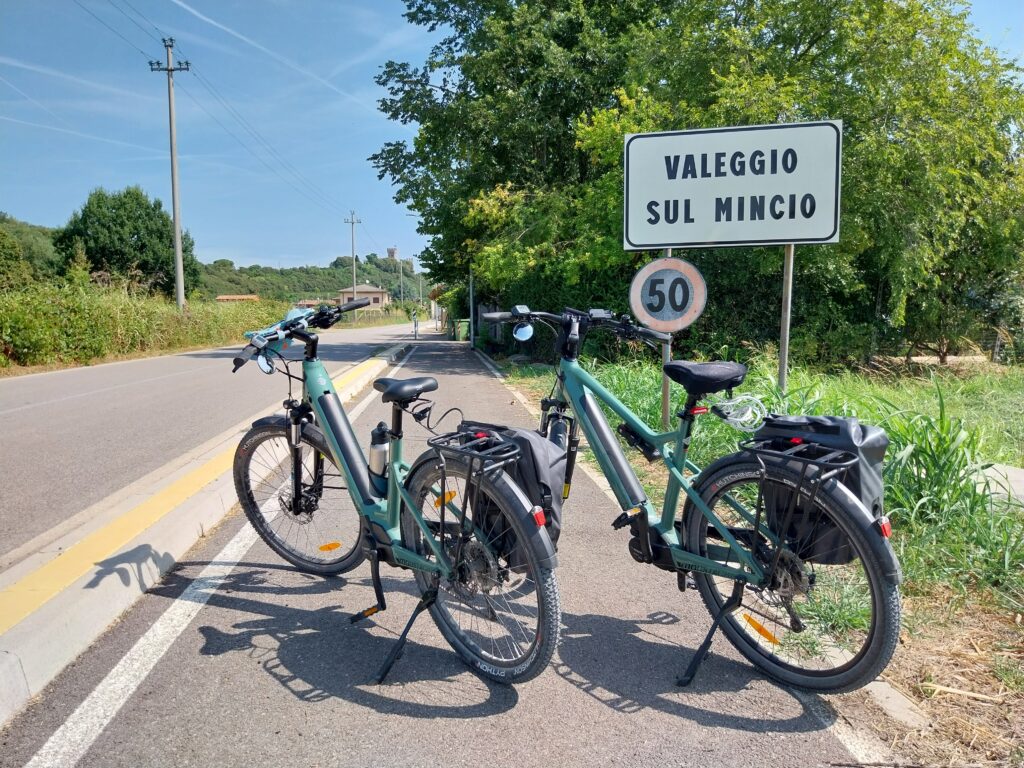
- Distance: 74 km
- Elevation gain/loss: +328/-321 m
- Region: Lombardia and Veneto
- Period: August 2024
Discover a perfect 74-kilometer circular e-bike journey from the medieval village of Borghetto sul Mincio to Renaissance Mantua and back.
This comprehensive guide follows the scenic MN1d and MN1 cycle paths along the Mincio River, featuring spectacular lotus flower blooms, historic mills, and charming countryside.Experience cultural highlights including Palazzo Te and the Ducal Palace with Mantegna’s frescoes, plus a memorable boat excursion through the lotus fields. The route combines easy cycling through flat terrain with rich art, history, and gastronomy.
Route itinerary
Valeggio sul Mincio – Volta Mantovana (km 0 -> km 6)
We depart from Borghetto di Valeggio sul Mincio. The entrance to the cycle path is found by following the road on the left of the river, at the end of the parking lot.
The first section of the route will take us to Mulini di Volta Mantovana following the MN1 Peschiera-Mantova cycle path on the left orographic side of the Mincio river.
The cycle path is well signposted with an asphalted surface alternating with gravel sections, suitable for city bikes, mountain bikes and gravel bikes. It’s very popular with both local cyclists and tourists coming from Lake Garda, it winds entirely through flatland and in this section follows the curves of the river bends.
Volta Mantovana – Goito (km 6 -> km 16)
Having reached Mulini di Volta we leave the MN1 cycle path to cross the Mincio on the cycle walkway that leads to the other side of the river and continue following the MN1d variant.
On the small island in the middle of the river there’s the Chiosco dei Mulini, a stopping and refreshment point for all cyclists passing through here. Besides a breakfast or a cold drink, you can always have a chat with cyclists taking a break, get information about itineraries and help in case you have problems with your bicycle.
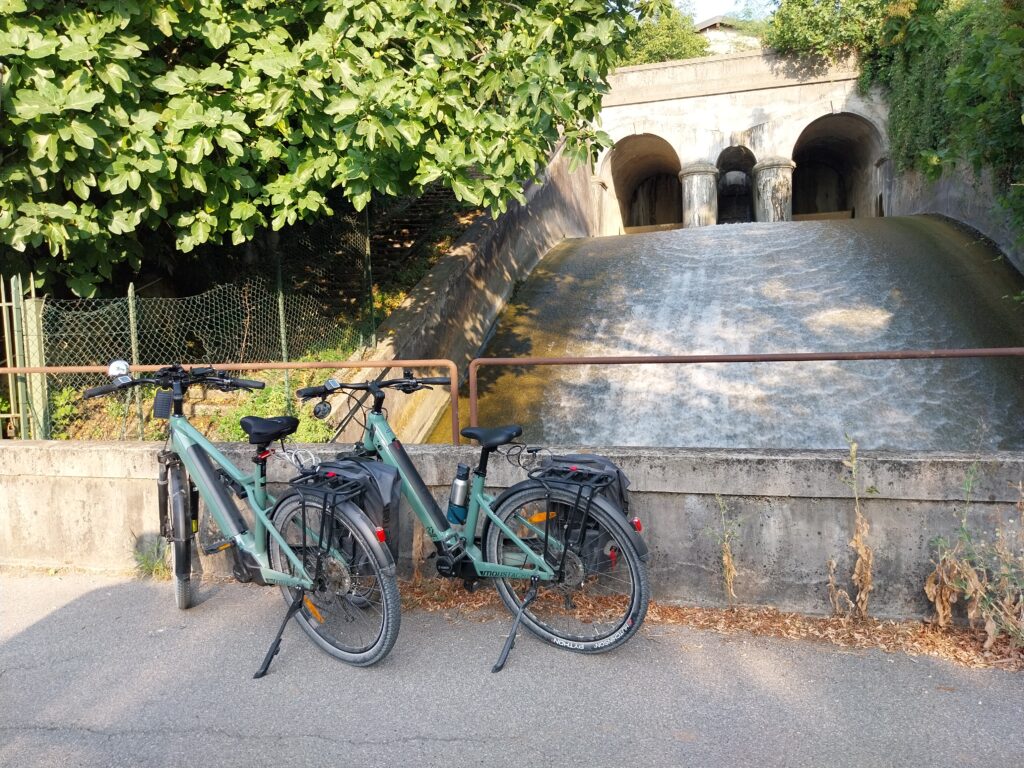
Having crossed the Mincio, the path climbs steeply for a short stretch, revealing to our eyes a suggestive water slide that gracefully plunges into the Mincio right where, since the sixteenth century, the old mills ground the grain that was brought to this place from the surrounding countryside.
At the end of the climb we resume the Right Mincio Cycle Path MN1d which continues keeping to the right orographic side of the river until Mantova. Despite the name, from here the cycle path route moves away from the river embankment to traverse the suggestive cultivated plain with its irrigation channels and dirt roads. For a good stretch of road we’ll only see the river in sections.
At km 8.9 our Right Mincio Cycle Path MN1d route would continue straight in front of us on a bumpy dirt road. We take it, but after a few hundred meters a prohibition sign specifying ‘non-cyclable road’ forces us to turn back. We don’t understand if the interruption is temporary or permanent but from experience, we know it’s wise to heed such explicit warnings when cycling in unknown territories. So to not lose more time we decide to make a small detour towards Falzoni and then try to resume the Right Mincio Cycle Path MN1d a bit further ahead.
Having descended to the locality of Falzoni we turn right onto Strada Torre (asphalted and with some cars) and after a couple of kilometers we find on the right the possibility to resume the MN1d cycle path. From here the cycle path continues on gravel without problems and then becomes asphalted again until Torre locality.
At Torre we return to the road (with little car traffic) which after a few curves returns to run alongside the Mincio until the sign at the entrance to Goito where on the left we exit the road to take the cycle-pedestrian path that enters the public gardens of Goito. We proceed slowly paying attention to the elderly people strolling and the children playing until we reach the Mill where there’s a bar restaurant. We find it closed, but its position directly on the river water makes it very appealing for a stop.
Inside the gardens it’s not possible to proceed further with the bicycle, so we turn right and exit the garden towards the center of Goito, we cross the town, then the very busy provincial road and after a few turns we resume the cycle path in the park that runs alongside the right side of the Mincio river.
Goito – Rivalta sul Mincio (km 16 -> km 27)
Having left Goito, the first section is entirely under the trees of a dense forest that runs alongside the Mincio river for about a kilometer, then you exit the forest and continue for another couple of kilometers on the protected cycle path that runs alongside provincial road no. 23.
At km 19.5, at Sacca, the cycle path breaks away from the provincial road and starts to follow the country lanes following the river’s course which however always remains out of sight.
We continue pedaling on asphalted country lanes without traffic until Bellacqua and from here we continue towards our next stop Rivalta sul Mincio.
At Rivalta sul Mincio you can go down again to the river bank at Parco Fondo Mincio where you can visit the small ethnographic Museum of river trades. Also here there’s the departure port of Navigazione Mincio which organizes boat excursions to discover the Valli del Mincio nature reserve.
However, we can’t stop because we have an appointment a few kilometers ahead at the Santuario Beata Vergine Maria delle Grazie.
Rivalta sul Mincio – Santuario Beata Vergine Maria delle Grazie (km 27 -> km 30)
Once we reach the square in front of the Santuario della Beata Vergine Maria delle Grazie, looking at the facade, on the right, there’s an arch. Having passed through the arch we descend into the garden that opens behind the sanctuary to reach the boarding dock of the Barcaioli del Mincio.
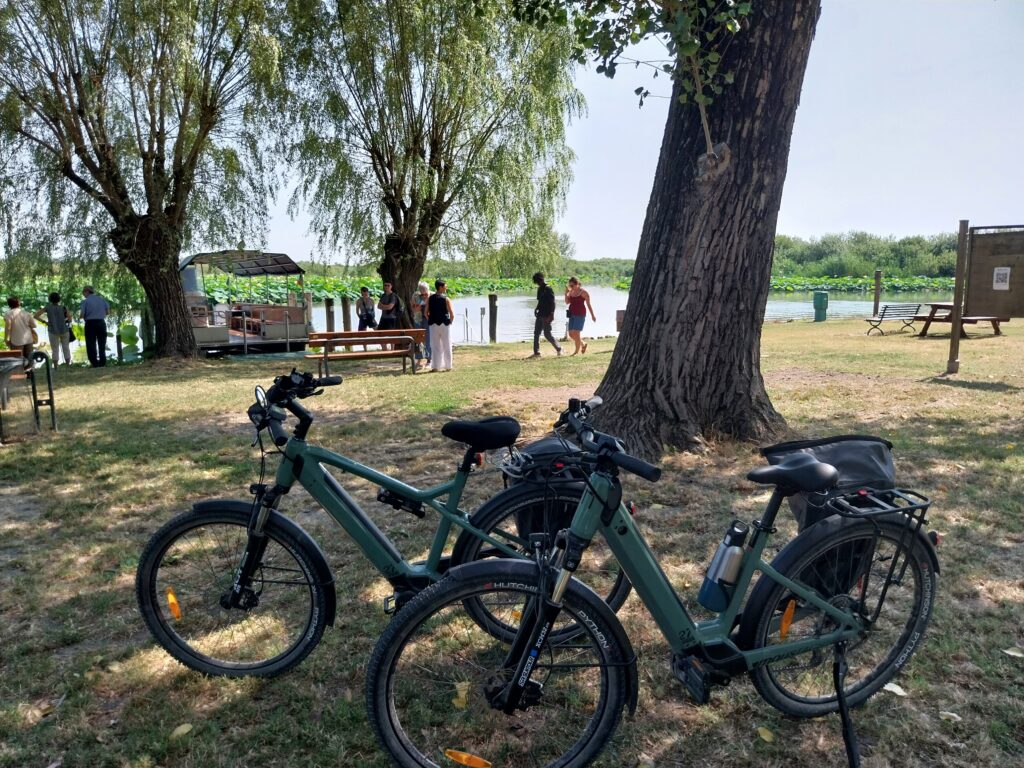
The Barcaioli del Mincio promotes knowledge and protection of the natural environment of the Mincio river and offers the possibility of taking guided itineraries by boat on the river.
The particularity of this stretch of the Mincio river is the presence of the Lotus flower. Introduced in the Upper Lake of Mantova in 1921, the Lotus flower completely disappears during the winter months to reappear between spring and summer with an imposing flowering that extends as far as the eye can see.
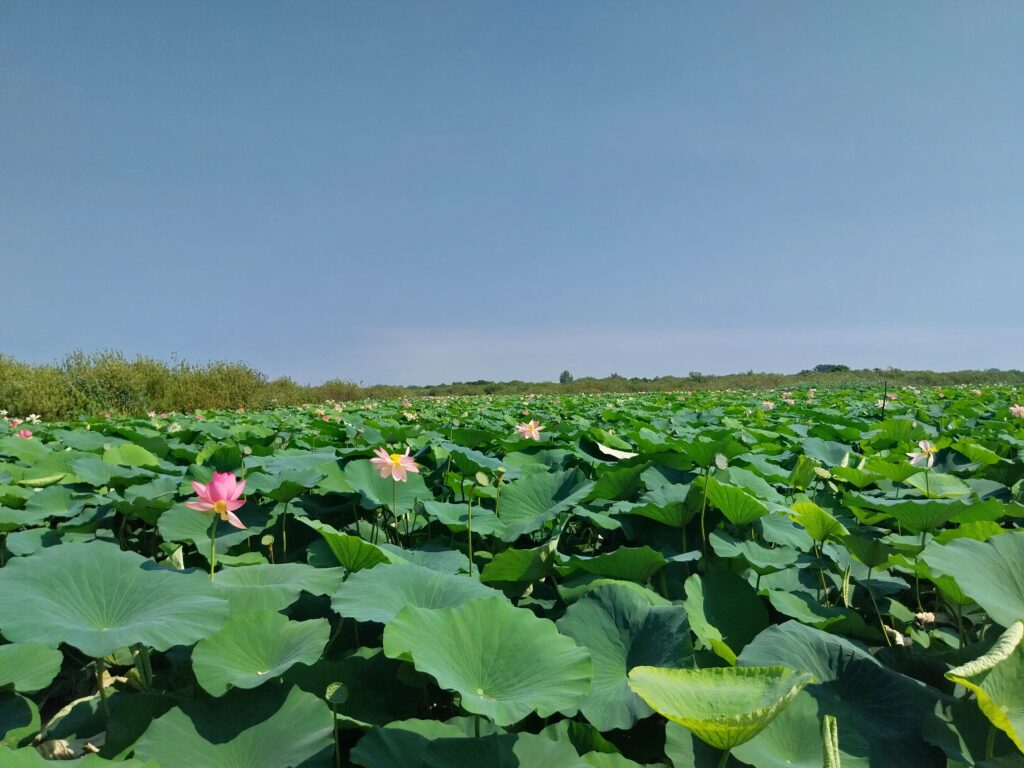
The flowering period is from June to August, but the best time to see the lotus in full bloom is around mid-July.
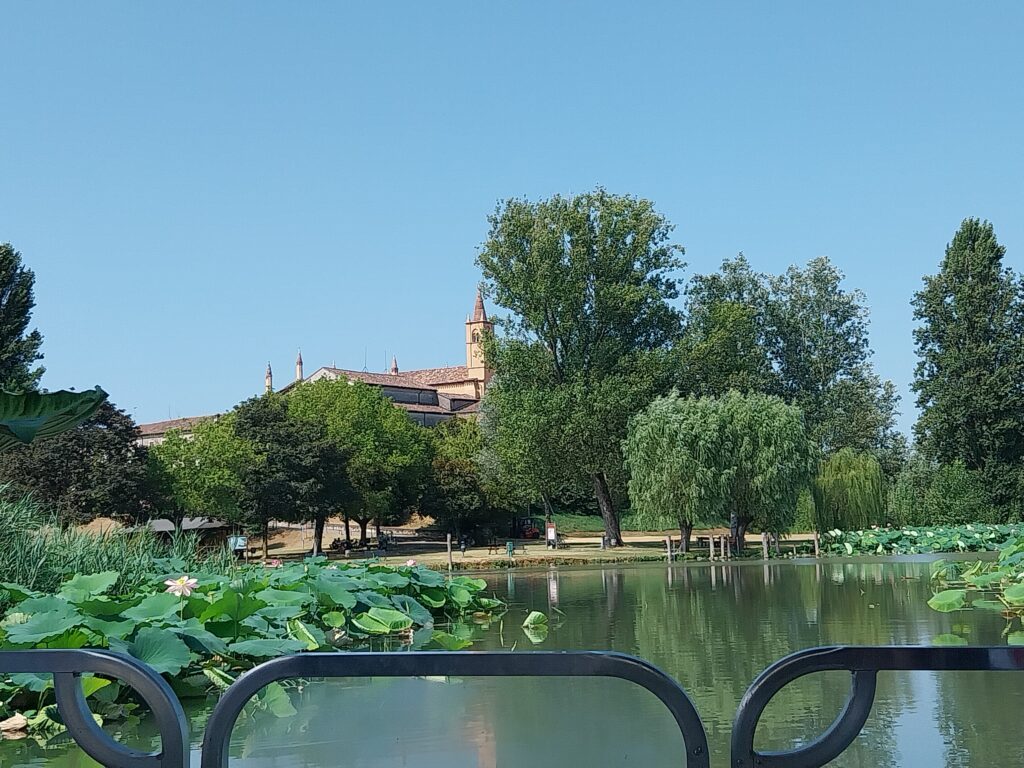
We recommend booking the boat excursion on the Mincio in advance, which lasts about an hour and a half, as it’s very popular during summer. If you book you’ll have to arrive punctually at the scheduled departure time, so evaluate well the distance you have to cover by bicycle and travel times based on your pace.
At the boarding point there’s a water fountain, a kiosk bar, open only in summer, and it’s possible to park and lock your bicycle.
The garden has comfortable benches and some tables and we take advantage of it to make a stop in the shade admiring the expanse of Lotus flowers from the shore.
Santuario Beata Vergine delle Grazie – Mantova (km 30 -> km 43)
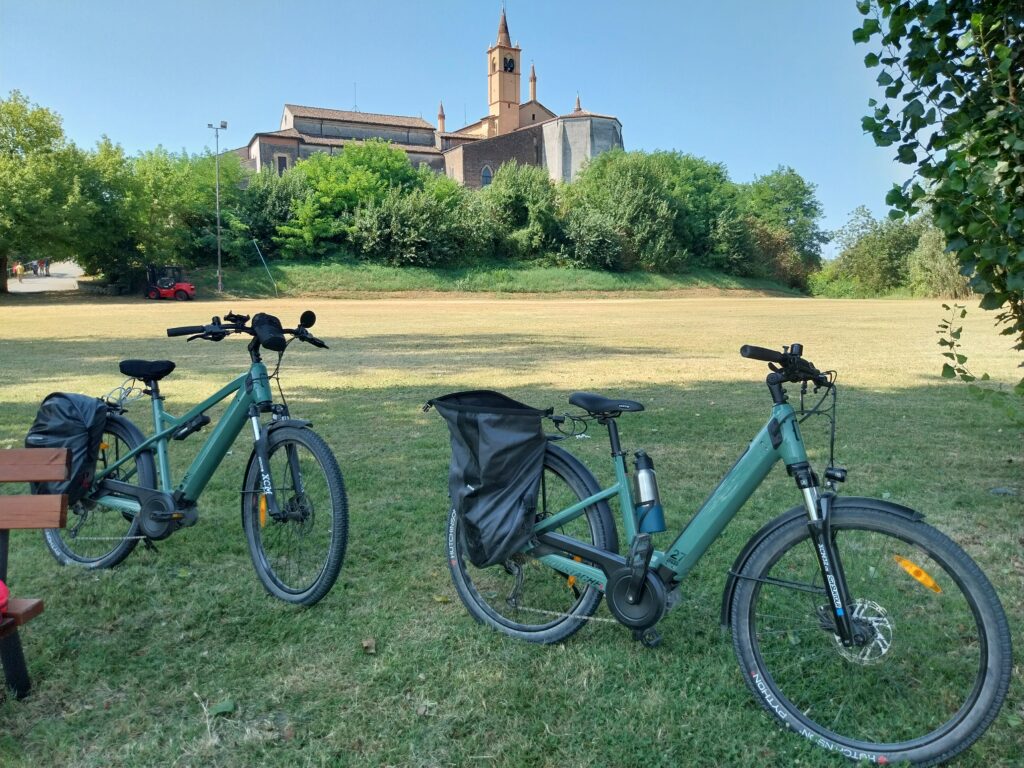
From the Santuario della Beata Vergine delle Grazie to the center of Mantova we still have 13 km of cycling ahead of us. It’s time to leave. We exit the Grazie locality and take the cycle-pedestrian path that will take us towards Curtatone and Borgo Angeli.
Here the MN1d cycle path runs alongside the SS10 Padana Inferiore which continues from Grazie towards Mantova. The state road is very busy but we’re on a protected cycle path so apart from the smog, noise and crossings it’s a safe stretch.
We continue like this for about 5 km until Castelnuovo Angeli where we leave the cycle path and turn left into via dell’Aldriga (at the pharmacy). The road is a dead end and seems to end at an agriturismo but at the very last meter, on the left, we find the entrance to the cycle path we were looking for.
The passage is narrow, the surface is unpaved, you need to pay attention to any pedestrians or bicycles you might encounter but after 300 meters and a couple of curves the path widens and the view opens as far as the eye can see over the Upper Lake to the city of Mantova.
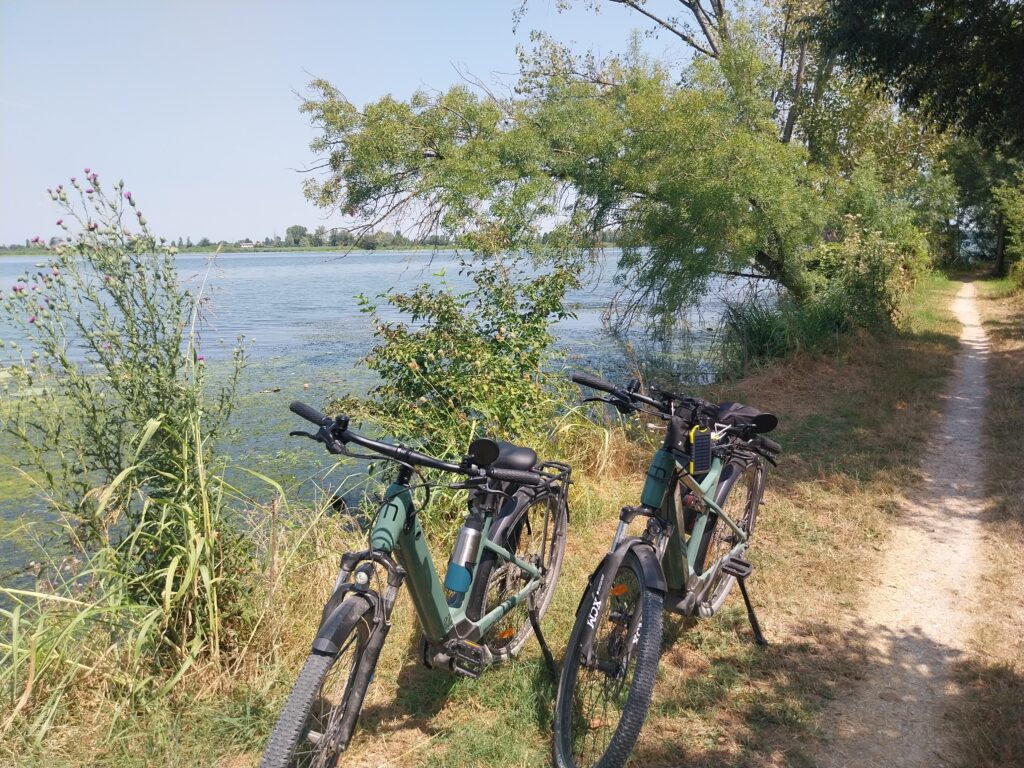
We pedal protected by the shade of the trees less than a meter from the river water, proceeding slowly so as not to disturb a Mute Swan a few steps away from us and to give a family of Mallard Ducks time to move off the path and descend into the water.
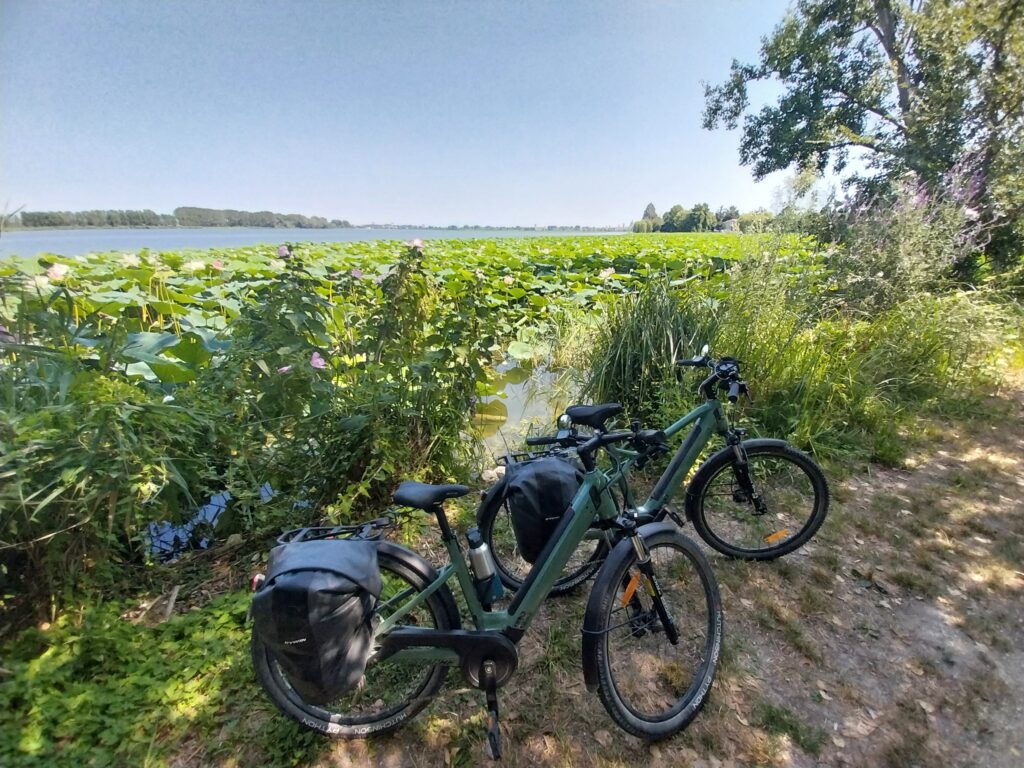
We continue like this for about a kilometer and when we exit this small oasis, we’re already in the first suburbs of Mantova. We cross the residential district of Belfiore at the end of which we find the SS10 again to take the cycle path that climbs on the right side of the viaduct. From here we proceed towards the city center always on the cycle path with short stretches on secondary neighborhood roads until we reach Palazzo Te.
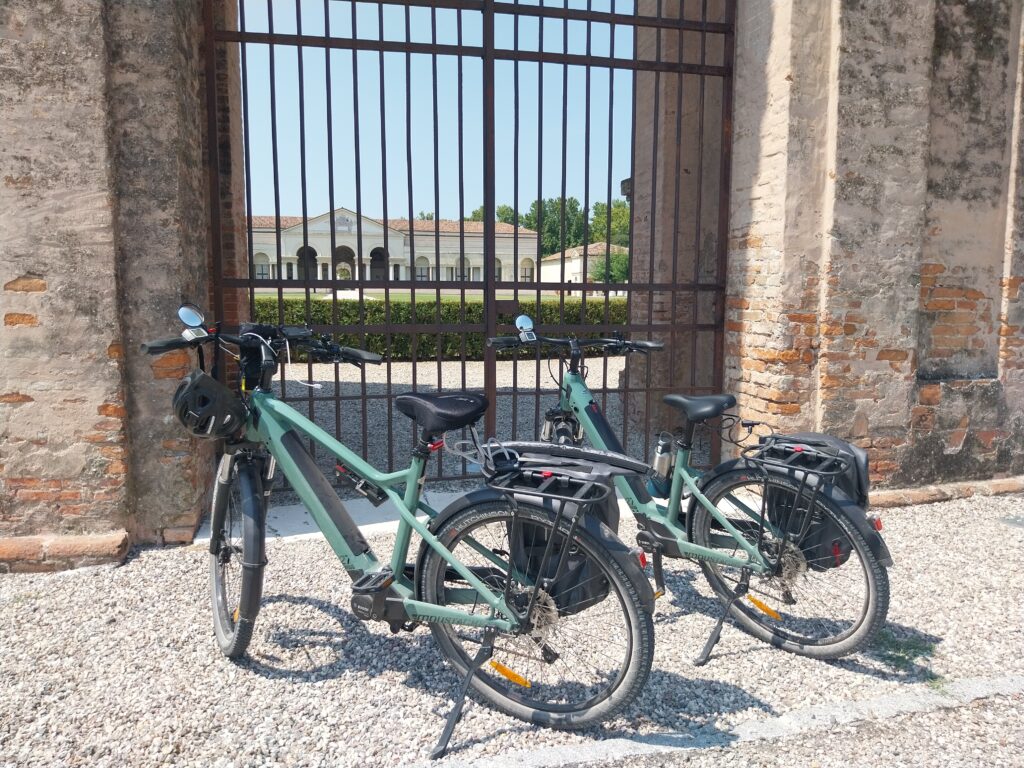
At Palazzo Te we plan a visit of about 2 hours, but there are no bike racks and not even a protected space to leave them, so we’re forced to chain the bicycles to a pole in the public garden in front. It’s not a pleasant solution, especially when traveling with e-bikes and bags.
Considering the investments that public administrations make in cycle paths and tourist promotion towards cyclists with magazines, testimonials, itineraries, maps, signage, it would take little to also create a small protected area where to leave bikes chained safely.
As usual we chain everything with three chains and cross our fingers.
Palazzo Te in Mantova is a magnificent example of Renaissance architecture, with breathtaking frescoes by Giulio Romano. The palace offers a unique combination of mythological and historical themes, making it a cultural treasure for art and history enthusiasts.
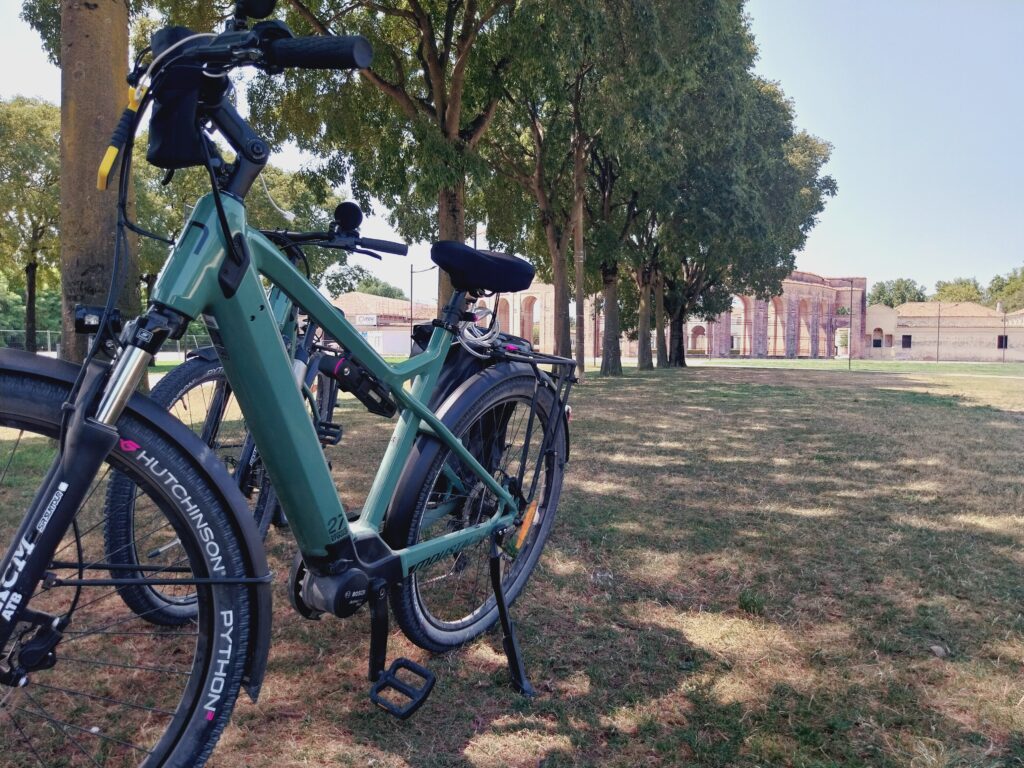
After visiting Palazzo Te, we rest a bit in the shade of the trees in the park and then head towards the historic center to visit the Ducal Palace of Mantua.
The road we chose, to avoid going the wrong way on a one-way street, is paved with river stones and is quite unpleasant to cycle on, fortunately it’s only 700 meters long, then we immediately arrive in Piazza delle Erbe and following via Broletto we enter Piazza Sordello where under the porticoes there’s the ticket office of the Palazzo Ducale.
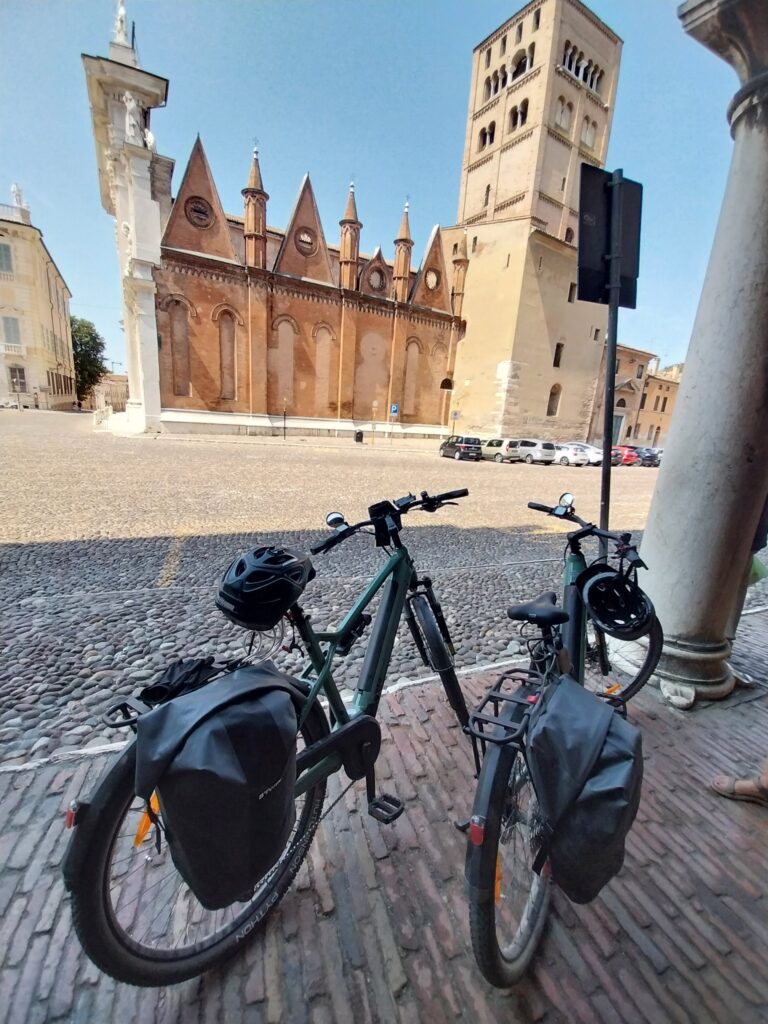
This time we find a small bike rack to tie our bikes to. Since there’s no line at the ticket office, once we’ve bought our tickets, we’re inside what was one of the most extensive royal residences in Europe.
The Ducal Palace in Mantua is an imposing complex that showcases the power and influence of the Gonzaga family across four centuries, with over 500 rooms, splendid courtyards and gardens rich in art and history. The palace houses the famous Camera degli Sposi (Bridal Chamber), with frescoes by Mantegna, a masterpiece of Renaissance art that alone makes the visit worthwhile.
The visit to the Ducal Palace lasts about 2 hours. Once we exit, we eat some gelato and then our visit to Mantua is also finished. It’s time to head back home.
Mantova – Soave (km 43 -> km 52)
The departure is from Piazza Sordello in Mantua heading towards Borghetto di Valeggio sul Mincio, following a section of the MN1 cycle path that connects Mantua to Peschiera del Garda.
The MN1 cycle path is very well signposted and paved, almost like a highway for bicycles. In some sections local traffic vehicles are also allowed, but we encountered very few of them. It’s also worth knowing that in the stretch between Mantua and Pozzolo, the MN1 doesn’t follow the river but runs alongside the Diversivo Mincio, an artificial concrete canal that uses a series of locks to regulate the Mincio river floods and brings water to the cultivated fields.
After leaving Mantua’s historic center, you take the cycle path on Lungolago dei Gonzaga which overlooks Lago di Mezzo (Middle Lake), then continue passing under the railway/road viaduct, then turn right and proceed to cross Lago Superiore (Upper Lake), still on the cycle path.
A couple of neighborhood streets lead us to the parking lot of the Mantua Rowing Club, which we leave on our left. After a couple more turns, the path begins to venture into the countryside, leaving the last houses behind.
You continue cycling in the countryside along a ditch until you encounter the Mincio Diverter, then proceed across the plains to Soave where a bridge takes us to the other side of the canal.
Soave – Pozzolo sul Mincio (km 52 -> km 65)
È l’occasione per una sosta al Bar della Polisportiva Pozzolese dove è possibile acquistare da asporto il Luccio in Salsa, un piatto tipico della cucina mantovana a cui in questo luogo è dedicata la sagra del Luccio in Salsa che si svolge ogni anno nel mese di settembre.
From Soave you continue on the MN1 with the diverter canal on one side, fields and farms on the other. The landscape is somewhat flat and monotonous, but after all we’re on the plains in an area dedicated to agriculture, so we can’t complain and we continue cycling for 13 kilometers until Pozzolo sul Mincio.
The Mincio Diverter begins at Pozzolo, so following the cycle path here you finally return to cycling alongside the river right at the level of the Polisportiva Pozzolese (Pozzolo Sports Club).
It’s an opportunity for a stop at the Bar della Polisportiva Pozzolese where you can buy takeaway Luccio in Salsa, a typical dish of Mantuan cuisine to which this place dedicates the Pike in Sauce festival that takes place every year in September.
Pozzolo sul Mincio – Borghetto sul Mincio (km 65 -> km 74)
Past Pozzolo, the landscape becomes more varied and the cycle path begins to follow the bends of the Mincio river. In about a kilometer we reach Mulini di Volta with its rapids and the characteristic small island in the center of the river where there’s the Chiosco dei Mulini, a rest stop much appreciated by cyclists passing through here.
On the way there, at this spot we crossed the Mincio to continue on the right side towards Mantua. Now that we’re going back up the river towards Borghetto, we stay on the left side of the river without crossing the bridge.
Another 5 kilometers and we arrive at Borghetto di Valeggio sul Mincio. We leave the cycle path and head towards the ancient village that seems frozen in time, between the sound of the waters and the old stones laden with history.
Crossing the narrow streets, with houses overlooking the river, is like entering another era, but the place is very crowded with tourists so we dismount and walk our bicycles by hand.
In the heart of Borghetto, the sound of water crashing against the old mills creates music that fills the soul. Here, time seems to have stopped, if it weren’t for the full restaurants and tourists intent on taking selfies on the bridge. But having arrived by bicycle and not by tour bus, we too are ultimately tourists here and can’t resist the temptation.
To find a moment of peace, we cross all of Ponte San Marco, turn left towards the parking area, and before getting back on our bikes we find a garden with benches overlooking the river where we sit to contemplate Borghetto with some calm.
We resume cycling and in a few hundred meters we climb up the opposite side of the river to take the Ponte Visconteo, imposing in its ancient structure. Crossing it is like taking a plunge into history, imagining the knights and merchants who, centuries ago, traveled the same route.
The bridge dominates the landscape offering a final view from above of all of Borghetto sul Mincio. We stop to contemplate once more the wonder of this place at sunset, and here our journey for today also comes to an end.
Recommended stops
- Boat trip on the Mincio to see the lotus bloom
- Palazzo Te in Mantua
- Palazzo Ducale a Mantua
- Borghetto di Valeggio sul Mincio
Where we ate
- Gelateria Loggetta in piazza Broletto a Mantova
- Al Re del Tortellino in Valeggio sul Mincio
Perfect for a sit-down dinner and to try Valeggio Tortellini and Pike in Sauce. - Pastificio Remelli in Valeggio sul Mincio
Also great for a quick lunch.
Places we passed through
- Valeggio sul Mincio
- Mulini di Volta Mantovana
- Goito
- Rivalta sul Mincio
- Santuario Beata Vergine Maria delle Grazie
- Mantova
- Soave
- Pozzolo sul Mincio
- Borghetto di Valeggio sul Mincio
Download GPX file
gpx route Valeggio sul Mincio – Mantova – Borghetto